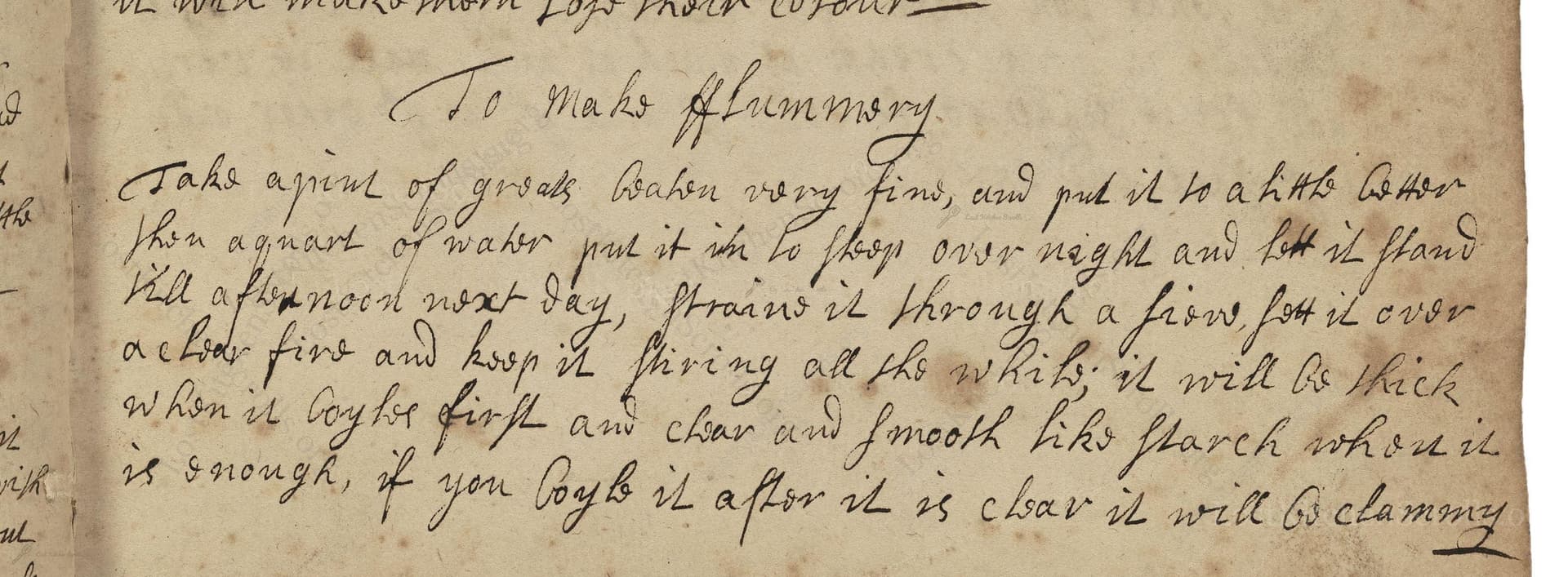
To Make Flumery
"Take a pint of groats beaten very fine, and put it to a little better then a quart of water put it in to steep over night and lett it stand till after noon next day, strain it through a sieve sett it over a clear fire and keep it stiring all the while; it will be thick and smooth like starch when it is enough, if you boyle it after it is clear it will be clammy"
Note on the Original Text
The recipe is written in the casual, immediate style of late 17th-century English household manuscripts, with little punctuation and no measurements as we know them. Actions are given as a sequence of commands, assuming the cook understands timing, texture, and desired consistency. Spellings such as 'boyle' (boil), 'lett' (let), and 'stiring' (stirring) are typical of the period, reflecting the variable orthography before standard dictionaries. This hands-on, oral style relies on sensory cues—the thickeness and clarity of the mixture—rather than precise directions.

Title
Receipt book of Jane Staveley (1693)
You can also click the book image above to peruse the original tome
Writer
Jane Staveley
Era
1693
Publisher
Unknown
Background
Step into the flavorful annals of the 17th century with Jane Staveley’s delightful culinary collection. Brimming with time-honored recipes and refined instructions, this book offers a sumptuous glimpse into the kitchens of yesteryear—where classic techniques met noble tastes and every dish was a celebration of ingenuity.
Kindly made available by
Folger Shakespeare Library
This Flumery recipe originates from late 17th-century England, a period luxuriating in new grains and domestic comfort food. Jane Staveley, an Englishwoman of some means, recorded this recipe in her personal collection around 1693–1694. Flumery was a popular, simple dish—an early form of what we might now call porridge or pudding—valued for its gentle, soothing texture. Historically, it was made from oats or, in later centuries, from wheat or even rice, as a way to transform humble grains into nourishing food.

In Jane Staveley's day, oat groats would have been beaten or ground by hand with a mortar and pestle. The mixture would steep in a covered earthenware or wooden bowl. Straining was done through a coarse cloth or hair sieve, and the thickening was performed over a 'clear fire'—meaning a well-tended hearth free of smoke and high flames—using heavy-bottomed pots and wooden stirring paddles. Every step required attention and arm strength, as achieving a smooth flumery was the mark of a careful cook.
Prep Time
10 mins
Cook Time
15 mins
Servings
4
We've done our best to adapt this historical recipe for modern kitchens, but some details may still need refinement. We warmly welcome feedback from fellow cooks and culinary historians — your insights support the entire community!
Ingredients
- 16.75 oz whole oat groats (or substitute with steel-cut oats if needed)
- 5 cups water
Instructions
- Begin by taking about 16.75 ounces of whole oat groats and grind them as finely as you can, using a food processor or high-speed blender.
- Place these ground oats into a large bowl and add approximately 5 cups of water.
- Stir the mixture well, then cover and let it soak overnight, ideally for at least 12 to 18 hours.
- The next day, let the mixture continue to steep until the afternoon, giving it a full infussion.
- When ready, strain the liquid through a fine-mesh sieve or cheesecloth into a clean saucepan, pressing the solids to extract as much liqiud as possible.
- Place the saucepan over medium heat and stir constantly with a wooden spoon or whisk.
- As the mixture heats, it will thicken—much like making a smooth porridge or starch.
- Continue stirring until it's thick and glossy.
- Do not boil after it has become clear and thick, or it will become gluey and overly sticky.
- Serve warm or allow to cool and set, depending on your preference.
Estimated Calories
150 per serving
Cooking Estimates
Prep involves grinding oat groats and mixing with water, which takes about 10 minutes. After soaking overnight, cooking the mixture takes about 15 minutes. The calories and servings are based on using oat groats and water only.
As noted above, we have made our best effort to translate and adapt this historical recipe for modern kitchens, taking into account ingredients nowadays, cooking techniques, measurements, and so on. However, historical recipes often contain assumptions that require interpretation.
We'd love for anyone to help improve these adaptations. Community contributions are highly welcome. If you have suggestions, corrections, or cooking tips based on your experience with this recipe, please share them below.
Join the Discussion
Rate This Recipe
Dietary Preference
Main Ingredients
Culinary Technique
Occasions

Den Bockfisch In Einer Fleisch Suppen Zu Kochen
This recipe hails from a German manuscript cookbook compiled in 1696, a time whe...

Die Grieß Nudlen Zumachen
This recipe comes from a rather mysterious manuscript cookbook, penned anonymous...

Ein Boudain
This recipe comes from an anonymous German-language manuscript cookbook from 169...

Ein Gesaltzen Citroni
This recipe, dating from 1696, comes from an extensive anonymous German cookbook...
Browse our complete collection of time-honored recipes



